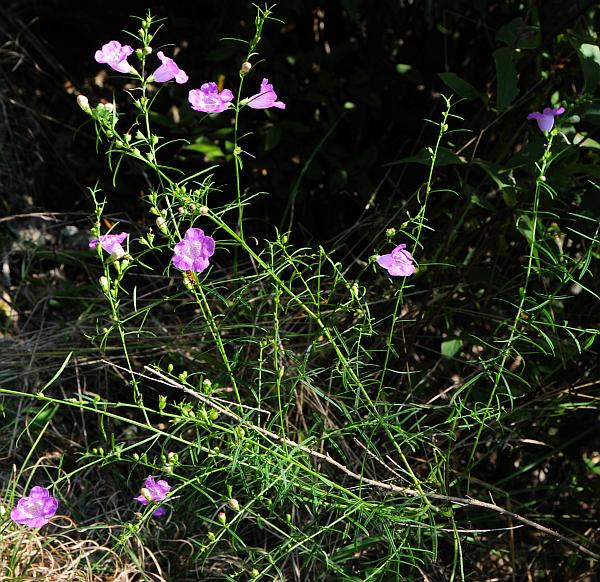Agalinis purpurea (L.) Pennell
Smooth Gerardia

Native
CC = 10
CW = -3
MOC = 8
SRank = S2
© SRTurner
Agalinis purpurea (L.) PennellSmooth Gerardia | |
 |
Native CC = 10 CW = -3 MOC = 8 SRank = S2 |
© SRTurner |
|
Family - Orobanchaceae Habit - Annual, hemiparasitic forb. Stem - Ascending or erect, to 1 m, with numerous, ascending to spreading branches, mostly above the midpoint, circular to bluntly 4-angled toward the base, more strongly angled and ridged above the lower branch points, glabrous or more commonly slightly roughened with sparse, ascending, minute hairs, mostly along the angles.
Leaves - Opposite, axils lacking fascicles of leaves or these noticeably shorter than the primary leaves. Leaf blades loosely ascending to spreading or arched outward, 15-70 mm long, 0.5-4.0 mm wide, linear, entire, the upper surface moderately roughened, the undersurface usually roughened along the midvein.
Inflorescences - Narrow racemes, the flower stalks 2-5 mm long at flowering (shorter than to about as long as the calyces), not or only slightly elongating at fruiting, more or less straight and ascending or curved outward.
Calyx - Calyces 4-6 mm long, bell-shaped, slightly longer than wide to about as long as wide at flowering (becoming distended as the fruits mature), the lobes 0.8-2.2 mm long, much shorter than the tube, relatively thick and triangular, glabrous, the sinuses between the lobes at flowering broadly U-shaped or occasionally broadly V-shaped.
Flowers - Corollas 17-33 mm long, pink to purplish pink, the tube moderately to densely but inconspicuously and minutely hairy externally, the throat with a pair of longitudinal, pale yellow lines and darker, purple to reddish purple spots, finely pubescent with relatively long, pink to purple, multicellular hairs at the base of the upper lobes, the lobes glabrous or sparsely to densely and minutely hairy on the outer surface, densely fringed along the margins, the upper 2 lobes spreading to somewhat bent backward. Anthers 2.0-3.5 mm long.
Fruits - Capsules 4-6 mm long, globose to subglobose. Seeds 0.7-1.2 mm long, black to dark brown.
Flowering - July - September. Habitat - Prairies, forest margins and openings, roadsides, moist disturbed areas. Origin - Native to the U.S. Lookalikes - Other members of the Agalinis genus. Other info. - This species is known in Missouri from only seven widely scattered counties, mostly in the southern half of the state. As of 2019 it carries a state conservation ranking of S2 (imperiled). Though not particularly common, the plant has been found in nearly all states in the eastern half of the continental U.S. Photographs taken at Otter Slough Conservation Area, Stoddard County, MO, 9-10-2019, and at Loda Lake, Newaygo County, MI, 8-11-2022 (SRTurner). |